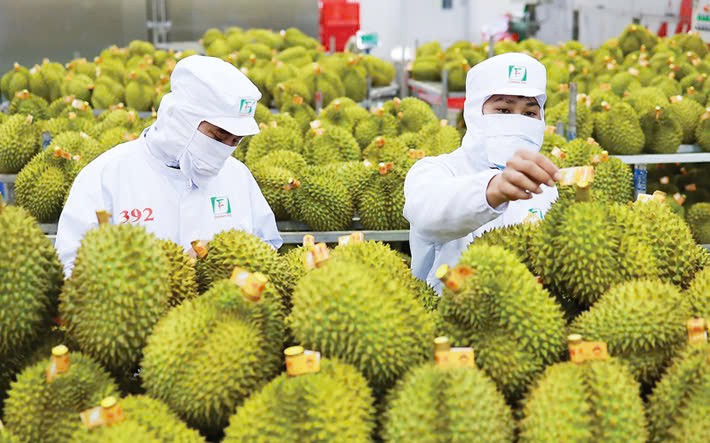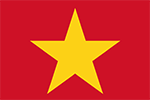Urgent solutions for Vietnam’s durian export problem
Tue, 08 Apr 2025 14:28:00 | Print | Email Share:
In Tien Giang Province, where durian is a key export, stakeholders are calling for urgent solutions to ensure the sector can adapt and remain competitive.
Mounting challenges for exporters
Vietnam’s durian exports, particularly from Tien Giang Province, are facing increasing hurdles in the Chinese market due to stricter technical trade requirements. Two major concerns have emerged as primary obstacles: the detection of cadmium, a heavy metal, and the use of the synthetic coloring agent Yellow O.
According to Mr. Vo Tan Loi, Chairman of the Tien Giang Durian Association, Yellow O is an industrial yellow dye applied to durians after harvest to enhance their visual appeal. Traditionally, turmeric was used for this purpose, but exporters switched to Yellow O because turmeric produced less consistent color, faded quickly, and was more expensive. The practice, adopted from international markets, has drawn increasing scrutiny from Chinese regulators.
 Currently, Vietnam's durian exports are facing difficulties due to technical barriers from China, forcing growers and businesses to overcome them to adapt. (Photo: daibieunhandan.vn)
Currently, Vietnam's durian exports are facing difficulties due to technical barriers from China, forcing growers and businesses to overcome them to adapt. (Photo: daibieunhandan.vn)
Although exporters have halted the use of Yellow O, residue continues to be found in shipments. Loi attributed this to lingering contamination on processing tools and equipment. Even if the dye is no longer applied, residual amounts may still be transferred to fruit during handling. Complete equipment replacement and rigorous sanitation are now seen as necessary to resolve the issue.
The cadmium problem, however, is more deeply rooted—literally. Studies have shown cadmium contamination in the soil of some durian-growing regions, believed to be the result of cumulative use of cadmium-containing fertilizers over past growing seasons. While some mitigation methods have been proposed, such as planting cadmium-absorbing crops like mint and water hyacinth, experts warn these solutions may only be partially effective, as cadmium tends to settle deep in the soil.
For newly established orchards that avoid cadmium-based fertilizers, the contamination risk is negligible. But for existing plantations, cadmium remains a pressing concern. Exporters have begun testing durians for cadmium residue before purchasing. However, the practice is not yet universal. Some businesses buy fruit first, then test it at their facilities. With each container requiring fruit from multiple farms, undetected contamination from even one source can jeopardize an entire shipment. The result is a climate of uncertainty and mounting anxiety across the industry.
“Everyone is asking the same question—how do we get rid of cadmium?” said Loi. “It’s a difficult time for the durian industry.”
Industry and government seek solutions
In response to the growing crisis, the Tien Giang Durian Association has submitted a series of proposals to provincial authorities in an effort to support both durian growers and exporters as they adapt to stricter Chinese import regulations.
One of the Association’s primary recommendations is to increase transparency regarding testing costs. Specifically, it urges local officials to publicly disclose the pricing of cadmium residue tests conducted by laboratories recognized by both Vietnam and China. By making this information available through official media channels, exporters could better plan financially and avoid being overcharged or misinformed during the inspection process.
The Association is also advocating for the establishment of local testing centers in Tien Giang. It has called on the provincial Department of Agriculture and Environment to coordinate with the Department of Crop Production and Plant Protection to open more testing facilities in the region. This move would help expedite the inspection and certification process, reducing logistical delays and making it easier for businesses to comply with technical requirements quickly and efficiently.
Another key proposal is to develop and promote model durian farming practices that meet international food safety standards. The Association believes that government agencies should assist in creating demonstration farms where growers can learn techniques to minimize pesticide use and reduce the risk of heavy metal contamination, particularly cadmium. These farms could then serve as reference models for larger-scale adoption across Tien Giang and other durian-producing provinces.
Finally, the Association is seeking support to strengthen cold storage infrastructure. It has asked provincial leaders to help connect exporters with commercial banks to secure financing for large-scale investment in freezing facilities. With proper cold storage, businesses would be able to stockpile durian segments during peak harvest seasons, providing a buffer in the event of customs delays or temporary restrictions at border crossings.
As technical barriers in the Chinese market grow more stringent, Vietnam’s durian industry finds itself at a crossroads. But with proactive collaboration between government authorities, scientific experts, and the private sector, stakeholders are working toward sustainable solutions that will protect the industry’s future and its access to a critical export market.
By: Phu Quy/ VEN
Source: https://ven.congthuong.vn/urgent-solutions-for-vietnams-durian-export-problem-57259.html
---------------------------------------------
Same category News :













